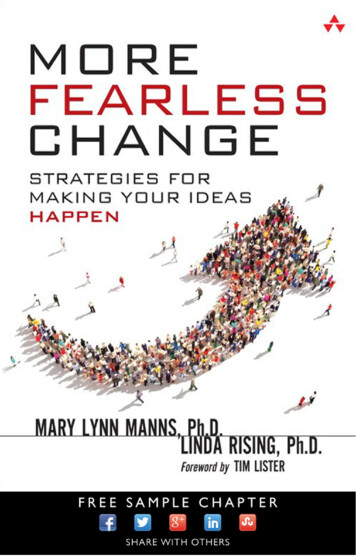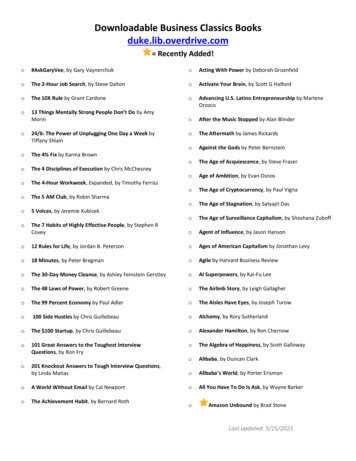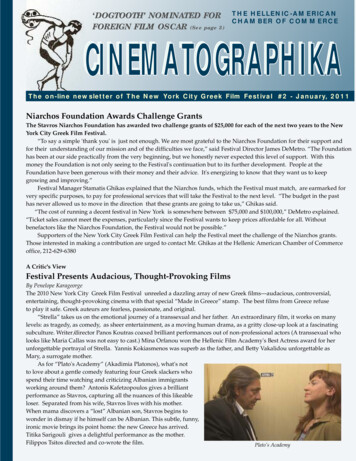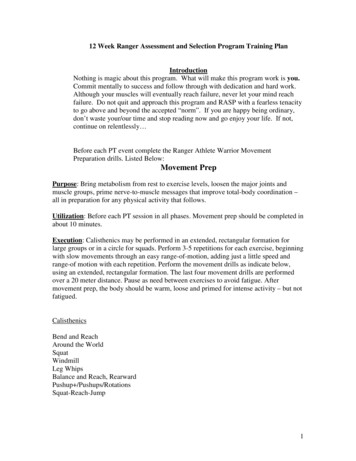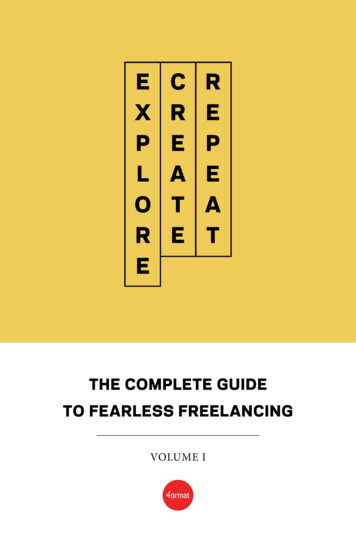
Transcription
THE COMPLETE GUIDETO FEARLESS FREELANCINGVOLUME I
ICommon Myths About FreelancingLydia PawlowskyIIOn a Limb: Is Branching OutNecessary for Success?Sean MinogueIIICreativity is the Best RoutineLydia PawlowskyIVChannel Your Inner BossSean MinogueVHow to Deal With Difficult ClientsLydia PawlowskyEXPLORE. CREATE. REPEAT. – by 4ormat.com
COMMON MYTHSABOUT FREELANCINGCHAPTER I– by Lydia PawlowskyMost creative professionals, at some point in their lives,have at least considered the option of quitting their office jobsto instead work as a freelancer. Freelance professionals arenot permanently employed by one company, and thereforeare “free” to take work on a project-by-project or client-byclient basis. Whether full-time or part-time, what is mostEXPLORE. CREATE. REPEAT. – by 4ormat.com
enticing about freelanced work is the self-employment,which some people believe to be synonymous with “totalfreedom”. This is not always the case. We at ECR have puttogether a short list to dispel (and occasionally prove) somecommon myths about freelancing.1) I can work from anywhere,at any time of day.This is often the biggest factor in deciding to go freelance,and for the most part, it’s a completely legitimate statementto make about your freelance career. What people don’t oftenaccount for in their rationale is the fact that more oftenthan not it is some higher power determining your workhours – whether it’s your client, your contractual employer,a deadline, or that mountain of paperwork you have to getaround to. Yes, you can work from home, yes your hours canbe flexible, but your hours ultimately have to be realistic.If you want to start work at 11 pm at night and end in the weehours of the morning, then consider freelancing for clientsoverseas – because if anyone in the same time zone wantsto get ahold of you and hash out some minuscule detail oftheir design, or ask some questions about a commissionedEXPLORE. CREATE. REPEAT. – by 4ormat.com
painting, it’ll be pretty hard to do when neither of you areavailable at the other’s convenience.With that in mind, people often assume that “freelance” issynonymous with “always available” – it’s not. Working fromhome, you get caught up in the mindset of “well I can do thisone thing for them, I’m not terribly busy right now” – butthe reason you aren’t terribly busy is probably because youhaven’t separated Work from Life, and now you have little tonone of the latter. It’s essential to set, and adhere to, personallimits regarding your work hours. While when you work mayvary day to day, pick a set number of hours you would liketo work each day. From there, take one or two of those hoursand dedicate it to doing your accounting and bookkeeping.File your invoices, make sure you got paid, plan what youneed to work on next – do this consis-tently enough that itbecomes routine instead of a massive headache.When breaking up the hours of your day, include time toget out and socialize, even if this just means going to buygroceries. Working freelance or working remotely oftenmeans you spend a lot of your time alone, and while a lot ofcreative professionals don’t mind this, “alone” can becomeone short step away from “lonely”.EXPLORE. CREATE. REPEAT. – by 4ormat.com
2) I’m my own boss.Somehow, the belief exists in many creative professionalsthat things get easier when you are self-employed. To someextent, that can be true – particularly because there are “lessfingers in the pie”. Whatever you’re working on, you directthe course of its creation and completion. Except, the morefingers there are in the pie, the less responsibility you have;instead of just focusing on the creative aspect, you are nowresponsible for communicating with the client, taking theircalls, having meetings, writing up a business plan, writingup contracts, making sure you receive payment, filing thepaperwork, handling your marketing, answering e-mailsand social media and being creative. And of course, whenyou’re working for a company, you get guaranteed work andusually some form of health insurance or benefits – and therisk of being laid off.Although you’re running all the shots of your own business,the people giving you business also have a say. To a degree,clients are the ultimate boss – but at least you can “fire”them if you need to. One thing to bear in mind though, isthe dreaded difficult client. Working for yourself, you oftenhave several projects on the go instead of focusing solelyEXPLORE. CREATE. REPEAT. – by 4ormat.com
on one, but different projects means communicating withdifferent clients. The next thing you know, you have two orthree hard-to-work-with customers instead of just one.Of course, self-discipline, motivation, and organizationwill prevail over all else – developing a system for handlingeach client or project is beneficial. Although you might beworking at home one day and from a cafe the next, generalconsistency and routine from project to project is key.3) I control how much money I make.This statement must first be preceded with the assumptionthat you will make money freelancing no matter what.You have no control over that. What you do have controlover, however, is how you ensure you are in a position tomake a profit. First and foremost – do not up and quit yourjob to freelance. Unless by “up and quit” you mean “createa game-plan and save up some money first”. Working freelance is different than any other typical office job becausea great portion of being successful comes from first testingout the waters and finding out what works best. And thetides do change.EXPLORE. CREATE. REPEAT. – by 4ormat.com
While there isn’t a larger corporation taking a cut of theprofit made from your work, or no other employees to pay,there are still a number of factors that determine whetheror not you “make it”. You choose how many clients or projects you work on at any given time, so you do have theoption of multiple income streams. But referencing thewater-based analogy used earlier, freelancing can come inwaves. Sometimes you will have an abundance of work (andtherefore wealth), and sometimes you might not. Sometimes clients will take a long time to pay you.The control that you do have is over how you spend yourmoney. In addition to your savings, devise a monthly budgetand a monthly average income that you need to reach tosupport your budget based on the averages of the lowestmonths’ pay you received last year, or if you’re on salary, lookat how much a few of the projects your company receivedwere worth. At worst, you can still support yourself, andat best, you will exceed your financial expectations.Devising a proper estimate is just as important as howyou budget your money. The most common mistake thatfreelancers make is by short-changing themselves in orderto seem more appealing to clients, to get more jobs.EXPLORE. CREATE. REPEAT. – by 4ormat.com
However, working for far less than the project is actuallyworth is detrimental to your bank account. With a properestimate, a proper contract is key to avoiding scope creep(unpredicted and often unpaid additional tasks that goalong with a project). Make sure to outline in your contractthe amount of revisions allowed before you can charge extrafor work or time that wasn’t originally accounted for in theinitial estimate. Of course, properly estimating a job onlycomes with time and experience (and often mistakes).Research what other professionals in your field are chargingfor their services, then develop strategic pricing from there.4) I only have to work on thingsI’m interested in.Working on only things you’re interested in can be widelytrue, if what you’re interested in is fairly broad. For instance,“print ads” versus “print ads for car companies” – very different. That being said, when you are working a field ascompetitive as the world of freelancing, you can’t afford toturn down potential work until you have an establishedclient base. Less work only means less money. If you likedesigning print ads, you might just have to suck it up anddesign websites sometimes too.EXPLORE. CREATE. REPEAT. – by 4ormat.com
Another common misconception is the idea of working onlywhen you feel inspired – which we would all like to believehappens more often than it actually does. Being creative,whatever field it may be in, takes just as much practice to begood at as it does to be good at accounting, or selling cars.That being said, it’s important to make sure to work evenwhen you are not inspired, which ties back nicely to the firstidea of setting a schedule for yourself. A blank page is notnearly as close to an end product as scribbles and mock-upsare, so by waiting for inspiration to strike, you’re not onlylosing out on the important process of creative development,you’re also losing out on billable hours.Freelancing can be a great way for creative professionals toself-manage their skills and their potential, as well as havepersonal control over their income and time, but it’s oftenhighly mythicized. It’s no easier or “better” than any otherjob – at the end of the day, doing a good job at what you dorequires just as much hard work and conscious effort in orout of a traditional office.Check out these helpful sites for getting started as acreative freelance: FlexJobs, Freelancer, Guru, E-lance,FreelanceFolder, FreelanceSwitch, ModernFreelanceEXPLORE. CREATE. REPEAT. – by 4ormat.com
ON A LIMB: IS BRANCHING OUTNECESSARY FOR SUCCESS?CHAPTER II– by Sean MinogueThe rise of short-term contract work and full-time jobswith “kitchen sink” descriptions is making it necessary tothink strategically about what you offer as a creativeprofessional. Can a freelance designer who works only inbranding and packaging sustain a career in today’s world?Can a copywriter afford to be mystified by Photoshop?EXPLORE. CREATE. REPEAT. – by 4ormat.com
It’s a nightmare to be in the middle of an interview andsuddenly realize you’re missing a make-or-break skill that’llcost you the job. “I’m a quick study,” you insist. “I’ll get upto speed in the next week or two.” But the die is cast – you’reunder-qualified. All that’s left is for you to gather up yourportfolio, shake hands like everything went well, and findthe closest bar serving whisky.Although there’s no excuse not to evolve professionally,should you attempt to broaden your skill set in order toincrease your employability? The days of narrowing a singlecraft to a fine point are coming to an end, and only the bestamong us will nab the remaining unhyphenated positiontitles. It’s a matter of economic necessity – both for companieslooking to become more efficient, and for individualslooking for sustainable careers.Video Killed the Radio StarThe truth is that this isn’t a new problem; it’s an acceleratingone. In every industry, there are technological advancesdisplacing specialists. Wordpress, Tumblr, and Blogspot havespurred amateur web design and content creation. Instagramhas made photographers of us all. Digital cameras were theEXPLORE. CREATE. REPEAT. – by 4ormat.com
Big Bang equivalent in the independent film industry. Andeach of these innovations has nudged out, or reduced to avarying degree, the work that would have otherwise goneto dedicated specialists.It’s easier than ever to pick up new skills, and it’s never beenharder to accept that you don’t know enough. It may not bean appetizing prospect to seek out more student debt, but atleast an increasing number of institutions are thawing theirposition on á la carte education. The hard part is in researching the right course or workshop, and finding the time tomake it worthwhile.Another approach to reconnecting with your skill set is toattend networking events, such as Creative Mornings,which exist to foster dialogue about the creative economy.These gatherings are filled with people who have eitherexperienced similar career challenges or know someonewho has. Some-times the easiest way to solve a problem oruncover a self-imposed limitation is talking it out with alike-minded stranger.EXPLORE. CREATE. REPEAT. – by 4ormat.com
The Hipsters Are All RightThere’s something to be said for the revival of old schoolcraftwork. Identifying yourself as a singular professional ina niche field not only gives you a sense of pride about whatyou do every day, but it can also create a natural ecosystemof specialists. You don’t have to be a 20-something beardedprintmaker to appreciate the concept of clearly definedprofessions and career paths.The jack-of-all-trades, cost-cutting approach to the creativeindustry is at odds with the imperative to innovate withinour unique disciplines. Meaning: how can we push what’spossible if we’re spreading ourselves so thin by focusingmostly on doing more than just doing well? A narrowapproach to career development might strain your bankaccount, but it could be the gamble you need to createmeaningful work.Grow – Don’t StrayIf you’re not content to risk the health of your career,you’ve got to evolve. One way to start is to establish yourown unique central focus, your driving mantra. Are you adesigner who writes? Maybe a photographer with videoEXPLORE. CREATE. REPEAT. – by 4ormat.com
editing chops? This process should take some time becauseit involves determining the characteristics of what a successful career looks like to you.Once you’ve got your professional raison d’être locked down –which puts you way ahead of most of us – you can beginmapping out some complementary, in-demand skills thatcan potentially help you achieve your career goals. Knowingwhat you want doesn’t mean you’ll get it, but at least you’llknow what you’re looking for. The rest is up to chance.EXPLORE. CREATE. REPEAT. – by 4ormat.com
CREATIVITY ISTHE BEST ROUTINECHAPTER III– by Lydia PawlowskyInspiration has the tendency to hit us when we least expect it;without a moment’s notice, it’s ignited and our minds becomeaflame with ideas. Yet too often, people confuse creativitywith inspiration – writing creativity off as a series of one-off ’sdue perhaps just to luck or talent.EXPLORE. CREATE. REPEAT. – by 4ormat.com
In all actuality, creativity is something that needs to beconsistently worked on, much the same as developing askill or strengthening a muscle. The key to optimal results,whether creative or otherwise, is routine. If you work on itregularly, inspiration will hit regularly.Let Your Routine be Messy (but Productive)Most creative professionals and freelancers relish the fact thattheir job provides them with (seemingly) endless flexibilitycompared to our working definition of what constitutes a“routine”. Whether we acknowledge it or not, what we trulyvalue is the freedom to create and customize our own routines –not give them up entirely. Routine, then, is not about makingcreative work dull or boring, but simply recognizing thatsome structure is necessary for success. Routine is supportive,not stifling.Making sure you spend a set amount of time working perweek supports the idea of not quantity over quality, but quantity becoming quality. By generating more creative output,routinely, it’ll become easier for you to identify and refinethose nuggets of gold. Consider, for example, the differencebetween writing 500 words a day (regardless of the day) andwaiting for that one perfect sentence before you even touchEXPLORE. CREATE. REPEAT. – by 4ormat.com
your pen to paper. If you were to go with the latter, howlong would it be before you even had anything at all writtendown? Would you ever? Your first creative step is not afinished product. Creativity is messy, and routine allowsyou to be messy in a way that’s conducive to productivity.Avoid Interpretation, Hesitation, FrustrationDeveloping a routine for your creativity is a matter ofconditioning yourself to produce consistent creative results.In short, art is your business: professionalize it. Practicealways makes perfect, so training yourself to get into acreative mode during specific conditions. For instance,sticking to a certain time schedule, environment, or musicchoice while working will allow you to format your focusaccording to that “trigger”. Regardless of what you decideto “control”, your routine has to be unique – something youdon’t associate with other activities. You have to isolateyour routine, and bring it into focus.This could also mean avoiding doing certain things if theytake you out of the right frame of mind – like constantlychecking up on your social media or deciding to balanceyour checkbook in the middle of a project. Devote yourEXPLORE. CREATE. REPEAT. – by 4ormat.com
creative time solely to creating, and get in the habit of doingso. Determine what tasks you need to complete in your day(or week) and set time aside for each one. Although webelieve that “last minute inspiration” is best, rushing canactually end up killing our creativity. In rushing throughthings, we aren’t really focused one hundred percent on whatwe’re doing. And there’s no guarantee that lightning willstrike on demand.By developing a work routine to adhere to, you’re constantlykeeping both your technical and well as problem solvingskills sharp – like keeping a gear well oiled. Setting limitations and conditions for yourself also provides just the rightamount of pressure you need to get things done – workingsans routine leaves too much open to interpretation,hesitation, and frustration.Be Creative – ConsistentlyOf course, you’ll still have your “spark” moments of inspiration, but routine speaks directly to your productivity. Byeliminating the need to spend time making obvious decisionslike what to do (and when to do it), you ultimately free upyour mind for creative thought. The biggest differenceEXPLORE. CREATE. REPEAT. – by 4ormat.com
between a creative hobbyist and a creative professional isconsistency. Being creative is your job – it’s something thatyou work at to develop and excel at; it’s not something youpick up or walk away from when you so choose. Creativityis a habit that you shouldn’t break.EXPLORE. CREATE. REPEAT. – by 4ormat.com
CHANNEL YOUR INNER BOSSCHAPTER IV– by Sean MinogueFreelancers are their own worst enemies. We all slack offoccasionally and then work ourselves to the bone to catchup. We obsess over one project that we love and maybegloss over another we’re struggling through. Sometimes,we get so busy that our work process starts looking like theemergency room triage, which can distract us from ourown career goals. We might not have the freedom to actEXPLORE. CREATE. REPEAT. – by 4ormat.com
this way, for better or worse, if we had to answer tosomeone else.Being your own boss is one of the most attractive parts ofworking independently. You reap all benefits of your success,you determine project priorities, and you have the power todecide which clients you will work with. There are no middlemanagers patrolling bland, bureaucratic office environmentsto make sure you’re maintaining peak productivity. But onceyou take away the negative aspects of being constantly supervised, there are actually some great benefits in having to answerto someone else every day.What Good Bosses DoWe all have stories of working for nightmare bosses, butthat doesn’t mean good ones aren’t out there. It’s just harderto notice – and be thankful for – the positive influence theyhave on our careers. A good boss can be the most powerfulally you have for getting ahead in your field and progressingas a creative. They are never quite satisfied with your workand know how to push you harder. They focus your effortswith day-to-day direction and expect you to achieve certainmilestones along the way.EXPLORE. CREATE. REPEAT. – by 4ormat.com
This sense of expectation, that someone is paying closeattention to your efforts, is incredibly valuable. It creates anurgency to create, and without it many freelancers fail.Being our own boss means being a responsible captain ofour creative energy. The easier you are on yourself, theweaker your performance will be.As a creative, one of the most frustrating and beneficialaspects of having someone monitor your work is the criticalfeedback. If you have a boss, he or she is ideally someonewho has significant expertise in your discipline and canimpart that knowledge by commenting frequently on yourwork. The more organized and driven freelancers among ushave long recognized the value of peer review, and that hasspurred the growth of informal professional organizations(such as Creative Mornings).Be a Better Boss to YourselfIt’s tricky to provide yourself with the full positive influenceof a good supervisor, but there are some ways you can try –especially if you’re struggling with productivity. The goal isto make yourself accountable for your overall career. It mightbe helpful to think of it like this: you (the person) areEXPLORE. CREATE. REPEAT. – by 4ormat.com
working for You (the professional creative). Now, with thatslight division, you can try assessing your own performance.How well are you fulfilling your own expectations? Whatare some of your bad habits and how should you addressthem? Are there specific areas where you could improve inyour work?Freelancers who charge an hourly rate are already familiarwith recording how much time they spend on a particulartask. This kind of thinking is helpful throughout yourentire day as well. Online services like Toggl.com offer amore technical tracking system that can help you assessyour productivity.It’s a hard pill to swallow when freelancers discover thatworking independently doesn’t actually mean doing awaywith bosses, but becoming one. If you want to build a sustainable career on your own, you need to consistently actas your own best critic and mentor and cheerleader.It’s the kind of challenge that almost makes you miss yourold bosses. Almost.EXPLORE. CREATE. REPEAT. – by 4ormat.com
HOW TO DEAL WITH DIFFICULTCLIENTSCHAPTER V– by Lydia PawlowskyTaking the plunge into full-time freelancing is a liberatingexperience. Finally, your career is (mostly) on your ownterms, and you now have the power to make of it whatyou want. Unfortunately, business is a two-sided affair –which can be a particularly frustrating fact when dealingwith clients you don’t see eye to eye with. ECR has putEXPLORE. CREATE. REPEAT. – by 4ormat.com
together this freelancers’ guide to difficult clients to helpyou out in those less-than-ideal relationships.Plan AheadFirst and foremost, the best plan of action is a preemptiveone; take initial precautions to ensure you won’t have a difficult customer, and you probably won’t. The most commonproblems any freelancer has to deal with are clients whotake up too much of their time with frequent requests,being underpaid, and unrealistically-set goals or timeframes.Before even starting a job, avoid inevitable hassle by clearlyoutlining what the job is and what your role in it will be: bevery straightforward with your work expectations, and askthe client for their expectations. And then ask them to goover it again, to make sure you’re both really on the samepage. This should all be included a contract – specify whatthe work to be done is, your working hours, terms thatboth parties agree to, details about a down payment and“kill fee” (how much you’ll still get paid even if you have toterminate the job for whatever reason after a certain amountof time), assigned due dates or revision dates, and the listgoes on. It might be best to look at a few examples onlinebefore you get started. Also be sure to outline smallerEXPLORE. CREATE. REPEAT. – by 4ormat.com
details, such as how many revisions a client is allowed, whenyou should meet to show draft versions, and clarify whatwork is considered “outside the scope” (and what kind ofretribution you will be rewarded for completing this work).It’s worthwhile to consider tracking the details of a projector job on a collaborative platform, so that both parties haveaccess to the same information. Basecamp and Conceptboardare two collaboration apps that help to organize sharedideas/work.Communicate ClearlyYou’ve submitted your first draft/sketch/etc, and nowyour client is calling you incessantly to work out the details,because “it’s all wrong”. First, resist all urges to get mad. Or,get mad, but don’t do so at the expense of the client –maybe step away from your computer and don’t email themfor an hour until you can compose yourself. When that’sdone, ask for further clarification. This may require you toprompt them with very specific questions – do you not likethe colour, is the type not what you want, and so on and soforth. If time is of the essence, it may be helpful to ask yourclient to show you examples of what (in particular) they arelooking for, or something that is similar to the idea theyEXPLORE. CREATE. REPEAT. – by 4ormat.com
have in mind – anything to cut down the amount of timespent misunderstanding one another. The mistake that mostcreative professionals make is in asking an open endedquestion: “what don’t you like about it?” – to which peopleoften reply with an open ended statement: “I don’t know”.That is not productive. Proper communication is absolutelykey, so make sure to stay (sounding) positive despite howfrustrated you may actually be in reality. If you think theremight be a gap due to poor communicating, try reiteratingyour issues differently. If you think there might be a gap dueto lack of knowledge or understanding, try briefly explainingto them your reasons for X (without being a jerk). It’s important to get feedback before you get too far into anything,which is why you set up those check dates in your contract.When all of these snags have been smoothed out, the nextstep is to fix whatever they need fixed. After all, it is your job.ReevaluateThere is still a chance that even after putting on your bestcustomer service hat, the client will still prove to be difficult –and the ways are endless. With that being said, it’s time todo an audit of your time and efforts. Look at who or whatyou’ve been making the most money from, and what you’reEXPLORE. CREATE. REPEAT. – by 4ormat.com
spending the most time on. If your unreasonable client ismaking you the most money, then it may be in your bestinterest to stick it out, provided that working with themdoesn’t become unbearable or soul-sucking. If they’re justwasting most of your time, then from a financial standpointyou may wish to consider cutting them loose.There are also other valid reasons for letting go of a client.For instance, if there’s a seriously late or missing payment,if you face harassment, if they request you to do somethingillegal or immoral, or frequent contract breaches (like notrespecting when your working hours are, or failure to meetcertain obligations).Remember, a bad client is ultimately more than just that –it’s a bad situation, and one you need to either remedy orget yourself out of, if the losses outweigh the gains. If youdo have to “fire” a client, remain as neutral as possible, soas to not make the situation any worse than it already is.Simply tell them that you don’t think your services are meeting their needs any longer. In your contract, it would bebeneficial to include details about the possibility of thissituation – what work you will give them, what they willhave to pay you, etc. Firing a client is not the worst thing inEXPLORE. CREATE. REPEAT. – by 4ormat.com
the world. If you weren’t complying to contractual agreementsor were unable to meet their standards, you would most likelyget fired yourself; there is no reason a client should hold anunfair amount of “power” over you. Anything that keepsyou from fully being a professional is bad for business.EXPLORE. CREATE. REPEAT. – by 4ormat.com
Stunning & incredibly customizableportfolios for photographersTry NowSimply Professional.Dynamic themes.Your portfolio is quick& easy to create – andmobile/tablet ready.Choose from over 24professionally-designedmodern themes.Fully customizable.Use our drag and drop themeeditor to design your portfoliothe way you want.
option of multiple income streams. But referencing the water-based analogy used earlier, freelancing can come in waves. Sometimes you will have an abundance of work (and therefore wealth), and sometimes you might not. Some-times clients will take a long time to pay you. The c


